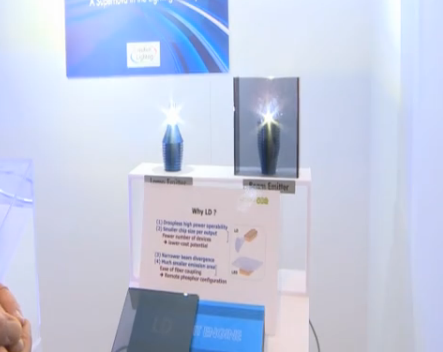LD Lighting is a new type of light source from Toshiba which uses lasers to light up an emitter. Not to be confused with LED, LD Lighting stands for “Laser Diode” lighting so instead of using broad emission LED like we are used to, the LD Lighting from Toshiba uses special laser diodes to create lighting energy. The laser diodes of the LD Lighting engine are mounted in a remote enclosure, very ballast like, and the blue laser light from them is combined and transferred to a remote light emitter which is packed with phosphors to produce white light.
Much like the Cree XT-E and its remote phosphor applications, the Toshiba LD Lighting engine takes that concept to a higher order of magnitude, with its blue light source capable of being placed up to 25 meters away from the emitter, that’s over 80 feet! The emitter itself includes the phosphors which convert the blue light to broad spectrum emission, and it also incorporates the optics necessary for different applications which so far includes broad angle or narrow beam “lenses”. The current LD Lighting system developed by Toshiba produces 4500 lumens using 90 watts, so it’s not breaking any records but as this technology matures it should come down in price while increasing efficiency.
LEDs are cool and all but having all the light of an aquarium emanating from a single point source like the end of a gooseneck would make for quite a dramatic display, nto to mention removing all the heat and potential electrical hazards from the setup. Laser Diodes are available for hobbyists to purchase and so are fiber optic components so its not out of the question for some interpid reefers to DIY their own LD Lighting engine even before Toshiba ever makes it available. What do you think, could you make use of a tiny little light source like this to light up small and large tanks alike? What else would it need to really make corals and fish really pop?
[vimeo]http://vimeo.com/41013622[/vimeo]




